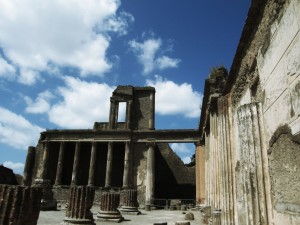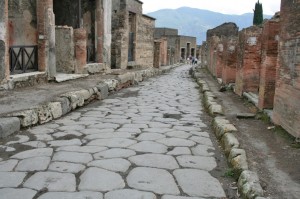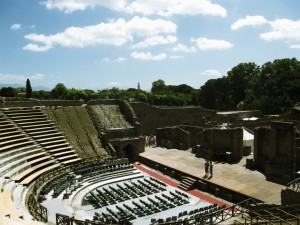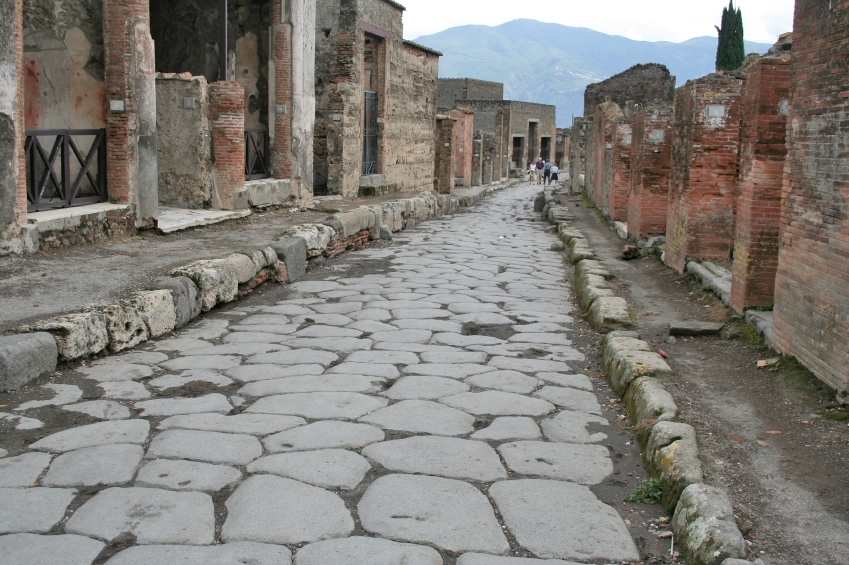Almost two thousand years ago, Pompeii was an important ancient Roman trading town and home to about 20,000 people. Farmlands and forests covered the fertile countryside, and the town’s bustling harbor was a center of trading activity.
Life changed forever when Mt. Vesuvius awoke with explosive fury on August 24, 79 AD, burying the town under volcanic ash and pumice stone. The once vibrant Pompeii was frozen in time.
 Pompeii is one of Italy’s most famous archaeological sites, and one of the most popular tourist destinations in southern Italy. Extensive excavations over the past two centuries have revealed the ancient Roman town and everything from precious artistic finds to everyday objects like jewelry, tools and home furnishings.
Pompeii is one of Italy’s most famous archaeological sites, and one of the most popular tourist destinations in southern Italy. Extensive excavations over the past two centuries have revealed the ancient Roman town and everything from precious artistic finds to everyday objects like jewelry, tools and home furnishings.
Over many years, scholars have pieced together an image of what life was like in Pompeii just before the disaster. What makes Pompeii such a priceless find is that the entire city was preserved, allowing us a glimpse of life from the elite Romans to servants and gladiators.
Standing at the Porta Marina, the main entrance gate, I imagine the city coming to life around me. I can almost hear the clattering of the carts up and down the busy Via Marina heading down to the harbor. Two thousand years ago, before the eruption of 79 AD, the town’s harbor on the Bay of Naples came nearly up to the edge of town.  Looking to the left before the Porta Marina gate, I can see the metal rings where boats used to be tied up while in harbor.
Looking to the left before the Porta Marina gate, I can see the metal rings where boats used to be tied up while in harbor.
Heading up Via della Marina I soon reach the forum—the heart of Pompeii—where the town’s main religious, political and commercial structures were located.
This is where crowds of Romans gathered daily to shop at the Macellum, the town’s main market, or to visit one of the temples dedicated to gods Apollo, Jupiter or to the Roman Emperor Vespasian. The forum was the hub of daily life in Pompeii, which took place under the watchful eye of Mt. Vesuvius.
The Via dell’Abbondanza leading away from the forum was the primary commercial street in town. It was originally lined with a mix of private homes and small shops selling all types of goods. In a bakery run by a man named Sotericus, I can’t help but think how much these ancient ovens look like modern-day wood fired ovens used to cook the famous pizza of nearby Naples. 
While wandering the streets of Pompeii, I could get lost stepping into the well-preserved villas of the ancient Romans and seeing how they lived. Villas such as the House of the Tragic Poet, the House of the Vettii and the House of the Faun are full of beautiful statues, mosaics and wall paintings that were discovered during excavations. Rounding a corner I think I can just hear the roar of the crowd watching a gladiator show at the Amphitheater.
Walking along the well-worn stones of Pompeii and glancing up at the graceful curves of Mt. Vesuvius, it’s hard to imagine this volcano holding such deadly wrath. Yet it was the destructive fury of Mt. Vesuvius that in the end preserved the town for us today. Pompeii’s beauty is at once enchanting and evocative, making it one of the most impressive archaeological sites in Italy.
 BrowsingRome Blogging about my experiences and sharing my thoughts about Rome, Italy and beyond
BrowsingRome Blogging about my experiences and sharing my thoughts about Rome, Italy and beyond


One comment
Pingback: Ruins at Ostia Antica are worth a visit — Browsing Rome